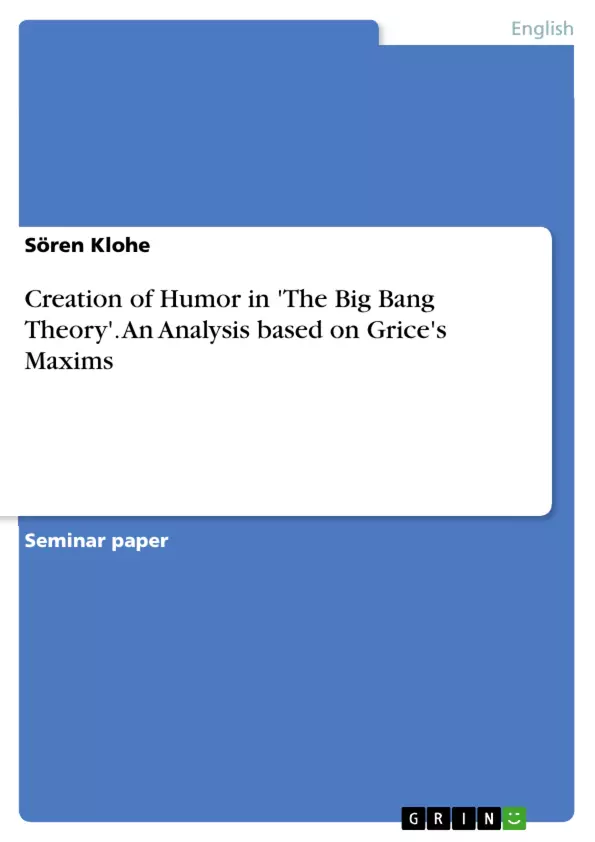I Introduction
The study of humor dates back to the ancient times when Plato and Aristotle formulated first theories as to why people laugh (Attardo 1994:18-19). In the course of centuries humor has become a complex field of study with numerous researches that have been conducted in various disciplines (Schnurr 2010: 308-309). Hence, humor has also been given attention in the field of linguistics, especially in its branches semiotics, semantics and pragmatics. Due to the extensive research by linguists like Attardo (1994), Raskin (1985) or Norrick (1993), verbal humor has become a thoroughly investigated field these days. While Raskin´s (1985) and Attordo´s (1994) research focuses on humor theories as well as analyzing the nature of jokes from a linguistic point of view, Norrick investigates the function of humor in the context of familiar conversations (Attardo 136- 137 , 145). However, it was not until recently that linguists have engaged with the analysis of humor in sitcoms; therefore comparatively few studies have been published in this area yet (Kalliomäki 2005: 4). This pragmatic approach to humor aims at investigating if humorous situations in the American sitcom ‘The Big Bang Theory’ relate to the violation of the maxims of the cooperative principle. Moreover, this study analyzes which humor strategies are produced by the violation of the Gricean cooperative maxims to elicit the audience´s laughter. The relevant research questions are:
1) Do humorous situations relate to the violation of the maxims of the Grice´s cooperative principle?
2) If 1) is the case, what are the characteristics of the humor that is produced through the violation of a maxim? (i.e. Which maxim is violated? Which humor strategies are employed by whom and in which context?)
3) Does a character create humor by intention or unintentionally?
The qualitative analysis in this paper is supposed to contribute to a better pragmatic understanding of the humor of the sitcom ‘The Big Bang Theory’. The data used in this study are obtained from the collection of scripts from season 1 and the DVD - recording. ‘The Big Bang Theory’ has become one of the most popular sitcoms in the US. It deals with four nerdy characters, the two roommates and physicists Sheldon Cooper and Leonard Hofstadter as well as their friends, astrophysicist Rajesh Koothrappali and the Jewish aerospace engineer Howard Wolowitz.
Inhaltsverzeichnis (Table of Contents)
- Introduction
- Literature Review
- Grice's Cooperative Principle
- Humor and the Violation of the Cooperative Principle
- Humor Analysis in 'The Big Bang Theory'
- Data Collection
- Analysis of the Violation of Grice's Maxims
- Violation of the Maxim of Quantity
- Violation of the Maxim of Quality
- Violation of the Maxim of Relation
- Violation of the Maxim of Manner
- Conclusion
Zielsetzung und Themenschwerpunkte (Objectives and Key Themes)
This paper explores the use of humor in the American sitcom 'The Big Bang Theory'. The study investigates the potential connection between humorous situations and the violation of Grice's cooperative principle, specifically analyzing the comedic strategies that result from breaking these conversational maxims. The key themes explored include:- The application of Grice's cooperative principle to humor in conversational settings.
- The role of maxim violation in creating humor, specifically in the context of sitcoms.
- The identification of humor strategies employed by characters to elicit laughter from the audience.
- The distinction between intentional and unintentional humor generation.
- A pragmatic understanding of humor as a tool for communication in the sitcom 'The Big Bang Theory'.
Zusammenfassung der Kapitel (Chapter Summaries)
The introduction sets the context for the study of humor and its evolution as a complex field of research across various disciplines, including linguistics. It specifically highlights the growing interest in analyzing humor in sitcoms, with a focus on 'The Big Bang Theory' as a case study. The introduction also outlines the research questions that guide the analysis. Chapter 2, "Literature Review," delves into Grice's cooperative principle, outlining its four maxims and attendant sub-maxims, and providing examples of how they apply to conversational implicature. It then explores the link between humor and the violation of the cooperative principle, discussing various perspectives on how the violation of conversational maxims contributes to the creation of humor. Chapter 3, "Humor Analysis in 'The Big Bang Theory'," discusses the data collection methods used in the study, focusing on the use of sitcom scripts and DVD recordings as sources for analyzing humorous situations. The chapter then moves into a detailed analysis of specific examples from 'The Big Bang Theory' to demonstrate how the characters' violation of Grice's maxims can result in humorous scenarios. The analysis delves into the specific maxims violated, the humor strategies employed, and the context surrounding these humorous situations.Schlüsselwörter (Keywords)
The study focuses on the application of Grice's cooperative principle to humor, particularly in the context of the American sitcom 'The Big Bang Theory'. Key concepts include the violation of conversational maxims, humor strategies, intentional and unintentional humor generation, and the pragmatic analysis of humor in sitcoms.- Arbeit zitieren
- Sören Klohe (Autor:in), 2012, Creation of Humor in 'The Big Bang Theory'. An Analysis based on Grice's Maxims, München, GRIN Verlag, https://www.grin.com/document/196608



